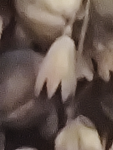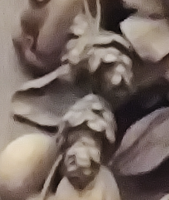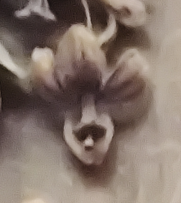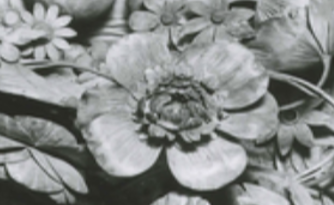1750s - research & making - carved flowers and the wide mantua - supporting thoughts of roses - part II
- Stephanie Smart
- Jun 27
- 16 min read
Updated: Sep 4
Silk History
"It is a commonplace of migration studies that people tend to move to where friends or families have already settled. By the final wave of Huguenot refugees in the 1740s and 1750s there was already well established communities to go to in London and Dublin. Lewis Gasquet fled from Nimes in 1752 “to avoid the Prosecution” there and followed a similar path to Huguenot refugees in the 1680s. After going to Lausanne he ended up in Holland. There he decided to go Dublin and “took the oaths and made the Declaration appointed by the Statute of King William for Encouraging French Protestants to settle in Ireland”. He later came to London and became a freeman of the Weavers’ Company."
Royalty
Imagine it is the 1750's. On the throne is George II - King of Great Britain and Ireland, Duke of Brunswick-Lüneburg (Hanover) and a prince-elector of the Holy Roman Empire from 1727 until his death in 1760.
Hampton Court Palace
Hampton Court Palace is experiencing its last period occupied by the royal family:
"When George II succeeded his father in 1727, the palace entered its final phase as a royal residence.
George and Caroline completed work on their apartments and started new works for the younger members of their large royal family. In 1734 Queen Caroline invited her favourite architect and designer William Kent to decorate the plain walls of the Queen’s Stairs. He created a Roman-style design, which included a tribute to Caroline, whom he compared to the ancient goddess Britannia."
Mantuas
And at court women are wearing the widest dresses ever to have been fashionable. Named after Mantua in Italy the silk they are, not only, made from but in fact made to show off, is so special and expensive that many will end up being cut up and altered.
Today
From the 1870s onwards there was a real fashion for dressing up in fashion from earlier in the 1800s. Because of that we only have 12 of the widest versions of the mantua remaining in Britain today. There are probably less than 40 in the world. Hand weaving the sort of silk seen on mantuas such as this one, cared for by the Royal Ceremonial Dress Collection, in the 2020's, is a rare and dying art.

© Historic Royal Palaces
from the Royal Ceremonial Dress Collection, cared for by Historic Royal Palaces
In other posts I will talk more about the historical links between textiles and money but I wanted to emphasise here that the widest mantuas, those of the 1740's and '50's, were literally designed to show off ones wealth (or that of one's husband). Historically textiles were expensive, therefore silk textiles more so, the larger the size piece you could afford the richer you obviously were. Cutting it allowed you to purchase a smaller piece but if you could afford the whole width of the roll you wore a dress that demonstrated this fact. The width of a roll of silk draped over a supporting structure known as a pannier is basically what a mantua is.
You can listen to the Historic Royal Palaces podcast about the court of George I here to hear more about court mantua, doorways being widened and the crush caused by women who were spread so wide sideways. Observations from the time include: "seeing a group of women entering a room wearing the court mantua was akin to seeing a fleet of battle ships advancing"
Suppôt des pensées - research
This post is written as part II of a set of IV. Rarely is there only one strand of research related to any single garment produced by The House of Embroidered Paper. Usually I track ideas, themes and imagery in many and various directions seeing how ideas interlink and therefore might be visually combined. At the crossroads of this exploration stand the individual pieces.
In part I, titled cream in Spitalfields, I explain why I chose cream as the background colour for the mantua that would be titled suppôt des pensées That is, in order to reflect the background colour of so much of the silk that came out of Spitalfields at that time. You'll also find out more about the Rococo S shaped curve that I would determine to incorporate into the decoration of this mantua. In part IV, sack back and sides, I strive to create an overview of different types of 18th century gown. Because across the decades the term mantua was linked to more than one design of dress. But before that, in part III titled paper, unicorns & roses, I detail the life and work of John Tate, Britain's first paper maker. As a paper artist, you can imagine I was interested to discover him and it was by doing that aspect of this research that I found the title of this piece. His watermarks, a lovely star/wheel shape and the English rose heavily influenced this design.
And it is with thoughts of roses that I want here to begin
"What's in a name, that which we call a rose by any other name would smell as sweet"
- William Shakespeare.
Said by some to have been Shakespeare's favourite flower the rose certainly is a courtly flower. It is the dreamy centre point of every English garden, linked to the Virgin Mary and the Virgin Queen It is symbolic of the House's of York and Lancashire but remains an analogy for every lovely English woman and is in fact England's national flower. There are many carved/three-dimensional rose forms at Hampton Court (above) including in the metal work by the Huguenot, Jean Tijou, which was created in the era of William and Mary (above right). The Tudor rose (sometimes called the Union rose) is the traditional floral heraldic emblem of England and it links earlier royal figures with later ones.
I came across the French description of paper as suppôt des pensées through my research into John Tate and when I learnt that he had made paper for Henry VII with the rose hidden in it, the watermark of a special batch, I knew that the papery dress of this name which I was planning would have roses all over it - supporting thoughts of England (of which, in the early 1700's Wales was a part). The Scottish thistle and Irish harp appear elsewhere in my research.
It seems appropriate that this dress has a French name. Not only because the French Huguenots were weaving silk in Spitalfields for the English court but because the history of British royalty is interwoven with European royal history and fashion history likewise. The mantuas that had the longest trains tended to be European. I knew my design would feature a train. it was set to stand at the bottom of the grand stone staircase leading up to the William III apartments at Hampton Court. It might be seen as symbolic therefore of where the Dutch royal family joined the British line. You can see something of my changing thought processes, regarding the length of that train in the design sketches below. At one point I was playing with the idea of a longer, narrower train.
I had been looking at dresses such as this:
From the Dressing the Georgians exhibition in the Queens Gallery 2023:
But by talking to Historic Royal Palaces curator of collections Polly Putnam I learn of the most appropriate style for the Dutch link I was making.
So I turned my attention to this dress from the Rijks Museum in Amsterdam: https://www.rijksmuseum.nl/en/collection/BK-1978-247 which I also found featured in a wordpress post by Atelia Nostglia who had visited there. I am grateful to her for permission to use these photos.
So I knew the train would be shorter. The sketches were working drawings all the way through. No design is set until a piece is finished. There are always moving parts. Things change in the making as I discover new techniques or undertake more research or have more conversations.
Roses
But back to roses! Certainly the velvety softness and the satin sheen of the petals of a real rose seem appropriate to a collection inspired by silk.
During my research I listened to an episode of Dressed The History of Fashion podcast with curator Amy de La Haye in which Amy speaks of the historic symbolism of the rose in fashion (in relation to her book The Rose in Fashion: Ravishing and the associated exhibition that she was involved in at the time of the recording with The Museum at FIT). These links may take you to the episode if not please do a search for it through your own podcast provider.
And I was finding roses all over designs in silk:

Roses abound from the 1700's to the 1900s
Here is a design that includes roses by L. Galy Gallien & Cie dated 1771
And there also examples of wild roses as can be seen in this silk panel of dress fabric from 1707
Embroidery
During the research I did at Macclesfield Silk Museum I came across this item (Object no. 2006/38). An Edwardian grey silk dress with embroidery (including roses) on the front bodice and sleeves, showing a Japanese influence. It was worn by Hannah Oldfield, wife of Albert Oldfield, the Mayor of Macclesfield from 1907-1908.
I liked the placement and shape of that embroidery, in the décolleté area. As you will see this helped inspire the necklace of suppôt des pensées.
note: the description of this dress reads: "in good condition - some soiling.
There are some holes in the dress: one on right arm, one just below
the waistband at the front and one on the back of the dress. Potential
missing lining, some small holes across the skirt. Collar almost detached
from the neck of the dress...Colour dove grey...skirt - 90cm; bodice
38cm...sleeves shoulders and bodice trimmed with 3cm wide ribbon machine
embroidered with prunus blossom. Central front bodice panel
ornamented with 3D embroidery of roses and leaves. Pin tucked netting
at throat and long sleeves. Front side panel finished with buttons. Hem
finished with dust brusher. Hook and eye back bodice fastening and
poppers at back to fasten skirt of the dress." I find such details fascinating
as it makes you wonder what happened - to cause the holes!
Did British moths eat this silk dress or did she travel?
Did she catch her right arm on something?
There was a related object (no. 2006/39), a silk parasol. I didn't see it but the catalogue contains a photo of it and it's tassel, a combination I know well from construction of Weeping Willow, the parasol, in The Regency Wardrobe collection

But I needed to be looking at silk from a different century. I particularly liked the roses seen here as part of cornucopia in the Spitalfields silk of this dress from the Museum of London which you can see in more detail and follow to its source by clicking on the image
I also began looking at historical illustrations of roses on paper:
"Pierre-Joseph Redouté... 10 July 1759 – 19 June 1840, was a painter and botanist from the Austrian Netherlands, known for his watercolours of roses, lilies and other flowers at the Château de Malmaison, many of which were published as large coloured stipple engravings. He was nicknamed "the Raphael of flowers" and has been called the greatest botanical illustrator of all time."
These included the work of Maria Sibylla Merian whose drawings of silk moths and worms I was already studying for another piece.
Provence rose, watercolour on paper by Maria Sibylla Merian, 1675 Wikimedia commons
Maria Sibylla Merian (German, 1647 – 1717)
I made a visit to the library at Kew Gardens (there are some interesting moths hovering around these roses):
Where I looked at printed versions of the work of Maria Sibylla Marian in:
Author Merian, Maria Sibylla (1647-1717) Publication Information Amsterdam : Voor den auteur, als ook by G. Valck, [1705].
General Note First published in Latin and Dutch, Amsterdam, 1705. Published also under title: Mariæ Sibillæ Merian Dissertatio de generatione et metamorphosibus insectorum surinamensium. Language Dutch Latin
and
Author Merian, Maria Sibylla (1647-1717) Merian, Dorothea Maria Henriette (1678-1745) Language Latin
Original version: Oiginally published as: Der raupen wunderbare verwandelung. [Parts 1&2] Nuremberg etc., 1679-1683 ; [Part 3] 1717
I was keen to see the work of Elizabeth Blackwell
I looked at two books:
volume 1 Author Blackwell, Elizabeth (1700-1758) Martin, William (Former owner) Publication Date 1737 1738 1739
Part II can be viewed here
and
Author Trew, Christoph Jacob (1695-1769) Blackwell, Elizabeth (1700-1758) Ehret, Georg Dionysius (1708-1770)
Added Author Blackwell, Elizabeth (1700-1758) Ehret, Georg Dionysius (1708-1770)
I moved on to Johann Theodor de Bry
Author Bry, Johann Theodor de (1561-1623) Vallet, Pierre (c1575-c1657) Language Latin/German
These are by Pierre Joseph Redouté
From
Author Redouté, Pierre Joseph (1759-1840) Publication Information Paris : Chez l'Auteur ... [and 5 others], 1827 [-1833]. Language French
And I discovered this Journal des roses in the bio diversity library
It was all lovely to look at but over the centuries between then and now certain types of illustrations of roses have become associated with chocolate boxes and in my portrayal of roses that wasn't what I was going for.
So the question became, how not to become twee?
Hapa Zome:
What did not sound twee (in relation to roses) was the technique known as Hapa Zome which I came across at the same time.
I learnt of it by attending a dye garden event at Ditchling Museum in Sussex. The technique involves bashing/crushing roses between sheets of cloth (or paper). You can see how it's done in this video: https://www.youtube.com/watch?v=6GCcsBtUo_c
I decided to have a go. The idea of squashing roses between sheets of paper with the aim of imprinting their shape into the paper's fibres seemed comparable, to me, to creating a watermark in paper as mentioned above.
The results were interesting. I wasn't fully convinced it was a technique I could utilise immediately in this dress but it is something I will remember for future work.
Paper cuts
Here I want to briefly mention the roses of Mary Delaney, a frequent visitor to court in the 1700's whose work I looked at in this post here.
She is worth returning to. Perhaps I will return to her over and again because her work in so relevant to my practise. Her paper mosaics are impressively botanically detailed (given her materials) and the translation of them onto fabric which she then wore to the Royal court makes her wonderfully relevant again here.
Part way through the making of this piece I was to discover that the Royal Ceremonial Dress collection holds pieces by her which I was excited to see.
Here you can see a single paper rose cut by Mary
which reminded me of this silk dress (late Victorian) donated by the philanthropist Sir Henry Tate with roses similarly placed on a black ground.
Sir Henry Tate, sugar magnate was a descendent of John Tate, the Medieval paper maker also to be lined to this dress who you can read about here
And today in garden centres you can find the beautiful rambling pink rose named after Mary Delaney. I had to buy it for my garden. They now also have it in the gardens at Hampton Court Palace.

It seems that Mary inspired another lady of her time. The two works in the links below are from a group of cut-paper flower illustrations bound into five volumes that curators at the Royal Collection understand were made by Charlotte Hanbury of Kelmarsh, inspired by Mary Delany’s work. Records of the contents on all the volumes can be found on their website by searching for Charlotte Hanbury as a creator.
In the same collection there a single cut-paper flower piece by Mary Delany herself which entered the Collection in the twentieth century https://www.rct.uk/collection/452388/a-stem-of-stock.
3-d roses
But I wasn't going to create two-dimensional paper cuts of roses for this dress either. And I wasn't going to embroider (the embroidery would be saved for elsewhere on the dress). So what was I going to do?
I had in fact been looking at the portrayal of flowers (including roses) using many and various materials, ie. not just paper or silk. This included the wood carvings on the wall of the William III apartments
Perhaps, I wondered, I could somehow create a carved effect (though using paper of course). It was an early idea that at one point I thought I was going to abandon but, in the end, it was the answer.
I began by taking a lot of photos.
And I was then lucky enough to be able to see able original drawings made by Grinling Gibbons
Making roses
The idea of three-dimensional roses made from paper intrigued me. I began by returning to the trusty craft of quilling. That is, myself and Sara Callarman, of The House of Embroidered Paper's volunteer team, spent many hours rolling long lines of quilling paper into disks to make the roses. These I found could be pushed and squashed about a bit and by doing so...well, you can see the results below
The solidity of these flowers I felt would work in certain places on the dress but not all. I came to the conclusion that I would want flowers that were three-dimensional but softer for the back of the train and it was Gilly Burton, one of the amazing team of volunteers who help the making of the work by The House of Embroidered Paper who created the paper felting technique we would go on and use. By sticking together layers of the paper tablecloth that is my staple paper and which for this project is being supplied as sponsorship by Duni Global she was able to start making gorgeous leaves and petals.
I combined both techniques with the design of the cornucopia on the silk of Ann Fanshawe's dress (shown above) and the idea of placing roses at the neckline, which I would repeat round the back.

On my original sketch I placed a rose on its stem on the back of the dress in place of the carnation I'd seen on the mantua with a long train. But with the cornucopia of roses to be placed over the bottom I wasn't sure if the dress needed more, so at first I experimented with Rococo S-curves in gold.
© Dressing the Georgians exhibition 2023
Stomacher
Mantua dresses have a stomacher - "a decorated triangular panel that fills in the front opening of a woman's gown or bodice".
You can see above where I landed with this but I had begun by looking at examples such as this one from 1720 with floral embroidery
© The Met Museum
British stomacher 1720 silk and metal
others include: https://theclosethistorian.blogspot.com/2015/02/closet-histories-no-43-stomacher.html
Then I came across this picture. I loved this combination of flower and fold. I also saw in it a hint of the Rococo S Curve I was looking at:
© MFA Boston Muff,French, Louis XVI, 1774–93
please click on the image to be taken to its source
Many other dresses during the 1700's incorporated roses:
please double click on each picture to be linked directly to the website © collection
Though the curves are made of ribbon on the muff above I decided to gather mine and whilst I could have put roses in the spaces created I returned instead to John Tate's other, standard watermark. Volunteers Kerry Crofton and Jane Quail embroidered sufficient that I could also apply them to roundels of card to make embroidered buttons for the sleeves and elsewhere.
Cuffs
I plan to examine cuffs in more details in my post sack back and sides but suffice to say for this dress from this era I was always going to have the large back areas to them and I decided to cover them with lace paper.
Interesting Grinling Gibbons, being the genius wood carver that he was even carved lace.
I also wanted to include some fly fringe so Kerry and Madeline began making it for this piece. In gold silk thread they began with a line of crochet chain stitch then made and inserted the flies. I am writing a separate post about fly fringe and other historic trim.

fly fringe
Dragons and Unicorns
At the start of this post I mentioned the Huguenot metal worker Jean Tijou.
"...born around 1650 in Paris, likely in the area of St Germain, just across the river from the Louvre.
Tijou trained as a metal worker, and there is evidence of him working for King Louis XIV, creating ironwork for the French royal palaces. He was a Huguenot, a French Protestant sect. As France became increasingly hostile to Protestantism, he fled his home and sought refuge in England in the 1680s.
Tijou was already a skilled and experienced metal worker and he quickly found patrons willing to pay him to continue his work. Though we don’t know exactly when he arrived in England, he is mentioned in the building accounts from Chatsworth in 1687, where he is paid for work on a stair balustrade by the Duke of Devonshire...The glorious 300-year-old Tijou Screen marks the southern boundary of the Privy Garden at Hampton Court Palace, next to the River Thames. It was designed for William III and Mary II."
Researching the theme of silk weaving, and the dramatic effect of Huguenot silk weavers which I detail here, has introduced me to the work of other Huguenots of equal technical ability in many other fields.
Jean Tijou must certainly be categorized thus. You can read more about his work at Hampton Court Palace here
It was there that I was able to see behind the scenes of the restoration of his work
And as I was looking for a central feature regarding the design of the skirt, creatures that echoed the sinuous lines of the Rococo S-curve seemed perfect.
I briefly considered placing a dragon facing a unicorn, the unicorn inspired by the mention of a type of paper called unicorn paper from the time of John Tate the paper paper maker and the specific image of a unicorn I was looking at taken, from the period of Tijou, from the coat of arms of William III
but in the end, if only for symmetry, we went for two dragons facing off one another, just as Tijou did.
Part of the process of making this dress has involved developing a new partnership. The RSN (Royal School of Needlework) is based in Hampton Court Palace and I asked early on if they might like for some students to be involved by adding hand embroidery to the dress.
It was very interesting to talk to the RSN about various historic techniques that we might need to employ such as pic and pounce used to transfer a design.
This is the background of this piece that they will be embellishing with hand embroidery, there's a long way to go. The finished piece will be viewable from spring 2027.
Weaving Silk Stories is a new project in partnership with the independent charity Historic Royal Palaces, which is due to launch in 2027.
Paper sponsorship by Duni Global













































































































































































































































































































